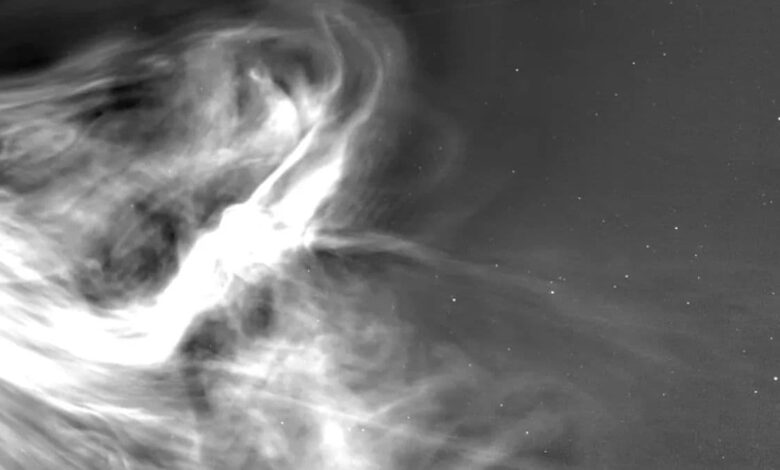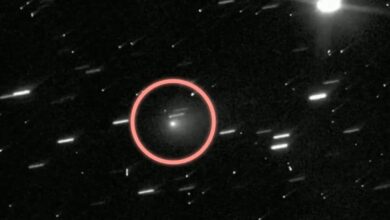Parker Probe’s Closest Images of Sun’s Corona

NASA’s Parker Solar Probe: Unveiling the Sun’s Secrets
In a monumental achievement for solar exploration, NASA’s Parker Solar Probe has delivered the closest-ever images captured from within the Sun’s corona. Released in July 2025, these groundbreaking images, taken a mere 3.8 million miles from the solar surface, offer unprecedented insights into the dynamics of our star.
On December 24, 2024, the Parker Solar Probe executed a daring flyby, venturing within 3.8 million miles of the Sun’s scorching surface, effectively entering the outer corona. During this pivotal pass, the probe’s Wide-Field Imager (WISPR) seized the opportunity to capture the nearest photographs ever taken of the Sun. These images showcase the Sun’s corona and the solar wind with remarkable clarity, exposing previously unseen solar eruptions, known as coronal mass ejections (CMEs), and intricate magnetic structures. This visual journey into the Sun’s dynamic atmosphere promises to revolutionize our understanding of space weather and significantly enhance forecasting capabilities.
Historic Flyby: A Glimpse into the Sun’s Atmosphere
According to NASA, this record-breaking flyby on December 24, 2024, allowed Parker’s WISPR to capture the closest-ever images of the Sun’s atmosphere, as the probe gracefully skimmed just 3.8 million miles (6.1 million km) from the star. NASA has unveiled captivating videos and still frames, revealing the Sun’s corona and the freshly released solar wind in stunning detail.
The new images provide, for the first time, high-resolution views of critical features such as:
- The heliospheric current sheet: The magnetic boundary where polarity flips.
- Collisions of multiple coronal mass ejections (CMEs).
Angelos Vourlidas, an imaging scientist, aptly describes the scene as CMEs “basically piling up on top of one another,” offering a unique perspective on these energetic events.
Unraveling the Mysteries of Solar Wind and Space Weather
NASA scientists emphasize that these images represent a significant leap forward in comprehending how the Sun influences space weather. Nicky Fox, Associate Administrator, highlights that Parker’s close-up view enables us to pinpoint “where space weather threats to Earth begin,” providing invaluable data for improved forecasting models. This is crucial for protecting our technological infrastructure and ensuring the safety of astronauts in space.
The WISPR images also corroborate key theories surrounding the solar wind. Parker’s findings suggest the existence of two distinct types of slow wind:
- One originating from helmet streamer loops.
- Another emanating from coronal holes.
These observations are instrumental in pinpointing their origins.
Project Scientist’s Perspective
Nour Rawafi, the project scientist, expresses optimism that solving this “big unknown” is now within reach, with Parker bringing us “closer than ever to uncovering their origins.” These groundbreaking discoveries hold the potential to safeguard astronauts, satellites, and vital technologies from the perils of dangerous solar storms.
The Significance of Parker’s Discoveries
The data gathered by the Parker Solar Probe is not just visually stunning; it’s scientifically invaluable. It allows us to:
- Understand the fundamental processes driving solar activity.
- Improve our ability to predict space weather events.
- Protect our technology and astronauts from solar storms.
| Feature | Description |
|---|---|
| Coronal Mass Ejections (CMEs) | Large expulsions of plasma and magnetic field from the Sun’s corona. They can cause significant space weather disturbances when directed towards Earth. |
| Solar Wind | A continuous stream of charged particles released from the Sun’s upper atmosphere (corona). It interacts with Earth’s magnetosphere and can cause auroras and geomagnetic storms. |
| Heliospheric Current Sheet | A vast, undulating surface in the heliosphere where the polarity of the Sun’s magnetic field changes. It is formed by the interaction of the Sun’s rotating magnetic field with the solar wind. |
| Helmet Streamers | Large-scale coronal structures that overlie active regions and prominences on the Sun. They are characterized by their helmet-like shape and are often associated with the slow solar wind. |
| Coronal Holes | Regions in the Sun’s corona where the magnetic field lines are open, allowing the solar wind to escape more easily. They appear as dark areas in extreme ultraviolet and X-ray images of the Sun and are often associated with the fast solar wind. |
Future Implications
The Parker Solar Probe’s mission continues, promising even more groundbreaking discoveries in the years to come. As it ventures closer to the Sun, it will undoubtedly unveil further secrets of our star, solidifying its place in history as a pioneering mission of solar exploration.




